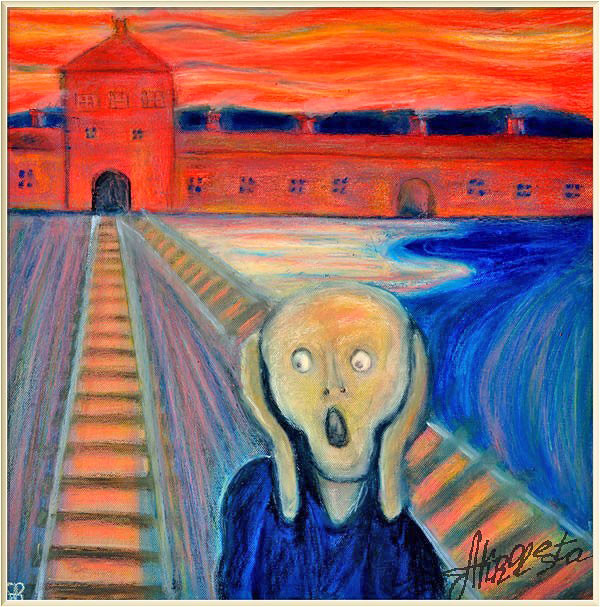The premonition of Munch (Portrait of the XX century)

Oil, pastel, canvas, 50x50. 2017-2018
A man from the painting of Edvard Munch looks around ... and sees the gates of the death concentration camp of Auschwitz.
In the foreground of the picture is a figure from the painting of Edward
Munch"s "Scream".
In the background is the entrance to the concentration camp of Auschwitz.
"The Scream (Norwegian: Skrik) is the popular name given to each of four
versions of a composition, created as both paintings and pastels, by Norwegian
Expressionist artist Edvard Munch between 1893 and 1910. The works show a figure
with an agonized expression against a landscape with a tumultuous orange sky.
Arthur Lubow has described The Scream as "an icon of modern art, a Mona Lisa for
our time."
Edvard Munch created the four versions in various media. The National Gallery in
Oslo, Norway, holds one of two painted versions (1893). The Munch Museum holds
the other painted version (1910) and a pastel version from 1893.
The fourth version (pastel, 1895) was sold for $119,922,600 at Sotheby"s
Impressionist and Modern Art auction on 2 May 2012 to financier Leon Black, the
fourth highest nominal price paid for a painting at auction.
Auschwitz concentration camp was a network of concentration and extermination
camps built and operated by Nazi Germany in occupied Poland during World War II.
It consisted of Auschwitz I (the original concentration camp), Auschwitz
II–Birkenau (a combination concentration/extermination camp), Auschwitz
III–Monowitz (a labor camp to staff an IG Farben factory), and 45 satellite
camps.
Auschwitz II–Birkenau went on to become a major site of the Nazis" Final
Solution to the Jewish Question during the Holocaust. From early 1942 until late
1944, transport trains delivered Jews to the camp"s gas chambers from all over
German-occupied Europe, where they were killed en masse with the cyanide-based
poison Zyklon B, originally developed to be used as a pesticide. An estimated
1.3 million people were sent to the camp, of whom at least 1.1 million died.
Around 90 percent of those were Jews; approximately one in six Jews killed in
the Holocaust died at the camp. Others deported to Auschwitz included 150,000
Poles, 23,000 Romani and Sinti, 15,000 Soviet prisoners of war, 400 Jehovah"s
Witnesses, and tens of thousands of others of diverse nationalities, including
an unknown number of homosexuals. Many of those not killed in the gas chambers
died of starvation, forced labor, infectious diseases, individual executions,
and medical experiments.
As Soviet troops approached Auschwitz in January 1945, most of its population
was sent west on a death march. The prisoners remaining at the camp were
liberated on 27 January 1945, a day now commemorated as International Holocaust
Remembrance Day. In the following decades, survivors such as Primo Levi, Viktor
Frankl, and Elie Wiesel wrote memoirs of their experiences in Auschwitz, and the
camp became a dominant symbol of the Holocaust."
From Wikipedia
Exhibitions:
Personal exhibition "JazzArt". 2018. Lithuania. EU.
Personal exhibition "SmartArt". 2021. Lithuania. EU.
Personal exhibition "Retrospective. Favorites." 2021. Lithuania. EU.
Media:
Visualization of the invisible. Magazine "Cosmo lady". Ukraine June 2018. pp
110-112. (Illustration)
What hangs in museums. Above Art Magazine. 28 Jan 2019 (Illustration)
Akrolesta’s SmartArt. Sig.ma. 2 April 2019 (Illustration)
The history of art in Akrolesta’s paintings. Homsk media. 17 April 2019.
(Illustration)
JazzArt - improvisations on the themes of the great painters. Discours magazine.
23 April 2019 (Illustration)
The history of art in Akrolesta’s paintings. Miscellany Artifex. 24 April 2019
(Illustration)
Worlds of Akrolesta. Culture and art 14 May 2019 (Illustration)
The constellation Akrolesta. Syg.ma. 19 May 2019 (Illustration)
Treasures of Akrolesta. Homsk. 20 May 2019 (Illustration)
Visualization of the invisible. Woman"s Era Magazine. July 2019. pp 112-114.
(Illustration)
From the history of painting. Culture and art. 10 July 2019 (Illustration)
Visualization of the invisible. Culture and art. 8 August 2019. (Illustration)
Akrolesta’s collections. Teletype. 24 August 2019. (Illustration)
Visualization of the invisible. Homsk media. 31 August 2019 (Illustration)
Art Stories from Akrolesta. Syg.ma. 7 September 2019 (Illustration)
Visualization of the invisible. Syg.ma. 3 Oktober 2019. (Illustration)
Bendravimo būdas, kuriam nereikia vertėjo. Vilkmerge. 2021-04-03 (Illustration)
Smart art by Akrolesta: art is communication that doesn't need translation. DELFI. March 28, 2021 (Illustration)
Parodoje „Retrospektyva. Mėgstamiausi“ pristatomi Akrolestos darbai. Vilkmerge.
2021-10-13
Russian expatriate opens exhibition in Ukmerge. DELFI, October 18, 2021
"Ретроспектива. Избранное"... DELFI, 21 октября 2021 г.
Akrolestos retrospektyva. Ukmergės renginių anonsai. 23 October 2021 г.
Искусство - свобода слова. LRT. Интервью и обзор выставки. 27.11.2021 (TV)
Price
1000 EUR
